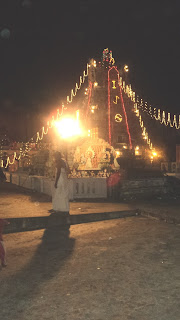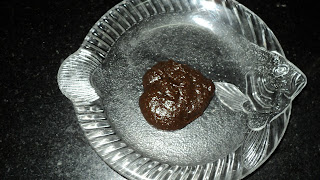Soorasamharam at Kandakottam - Part I
When we had a great
darshan of the
Soorasamharam at Vadapalani temple last year, Jayashree decided that she will take me to Kandakottam for this year
Soorasamharam. Who will get such a sister, who instead of just enjoying herself, ensures that I also get the pleasure out of such visits. Thank you
Appa and
Amma for such a sister and thank you Jay, Love you!
We had enquired at the temple and found that
Soorasamharam will take place around 7 pm. To find a comfortable place to stand, we reached the temple by 5.30 pm to have the
darshan of the Lord. Despite hearing a lot through my parents and grandparents, this was my first visit to this temple. I was thrilled to see the well decorated
gopuram (temple tower) but was a little bothered about the long queue which stretched to the road on the side of the temple. But the queue moved so fast that within 7-8 minutes, we were inside the temple.
It was a very quick
darshan and volunteers were pushing people as they had to accommodate a huge crowd. I just glimpsed the idols of Vallalar and Pamban Swamigal on the left. On our right was Murugan. Murugan looked very very cute in full
alangaram. I was surprised to see such small idols of Valli Deivayanai sametha Murugan. On either side of the
sannidhi were separate
sannidhis for Valli and Deivayanai.
We moved further to have darshan of Ganapathy in front of us and I was just allowed to read the words Suriyan and Veerabagu by which time the volunteers pushed us out. I promised myself to make a detailed trip to this temple again and blog about it including the legend and history.
As we came out the
Dwajasthambam was to our left and many ladies were lighting ghee lamps nearby. We moved to our right and reached a very beautifully decorated
mandapam. On the left side on a raised platform there were beautiful water
rangolis on plates. The
rangolis were of Ganapathy, Valli Deivayanai
sametha Arumugan, Gnanapandithan, Murugan on his
mayil vahanam, Natarajar and Vallalar. Inspite of being six days old, the
rangolis were looking beautiful and a lady nearby wondered how it would have been on day one.
On the right side near the decorated pillars was the
Urchavamurthy on
Mayil vahanam. It was a pleasure to have his
darshan. Like Thatha used to say, the youthful Murugan gives one so much cheer and energy! We had our fill of this Murugan and proceeded further.
The staircase next to this had “way to
Kandan Kalaiarangam”
written on it and people were going up and down. We too went up out of curiosity. We were delighted to see the
gopurams from there.
There was no programme happening at the
Kalaiarangam. But people were just sitting around and relaxing there.We came down and moved further right to have darshan of another
Urchavar. This happened to be Valli Deivayanai
sametha Arumugan complete with his
Vel and
Sevalkodi. All the six faces were looking so beautiful and benevolent!
We reached the side entrance of the temple and came out. While coming out, I could feel the presence of Murugan everywhere and the
Bhakthi of the people in that area and all around there were shops in the Lord's name.
We once again enquired about the timings and exact location of
Soorasamharam with a few people. We then reached the main road near Eithirajulu Naidu Sons and stood a comfortable place hoping to get a good view. The traffic was in full swing and people around were saying that it will be stopped the moment, Murugan comes out of the temple in
oorvalam (procession). While waiting in such a huge but organized crowd, I could not stop feeling proud of our country where we never give up such festivities and celebration for the sake of our livelihood, but make it a part of our lifestyle!



























